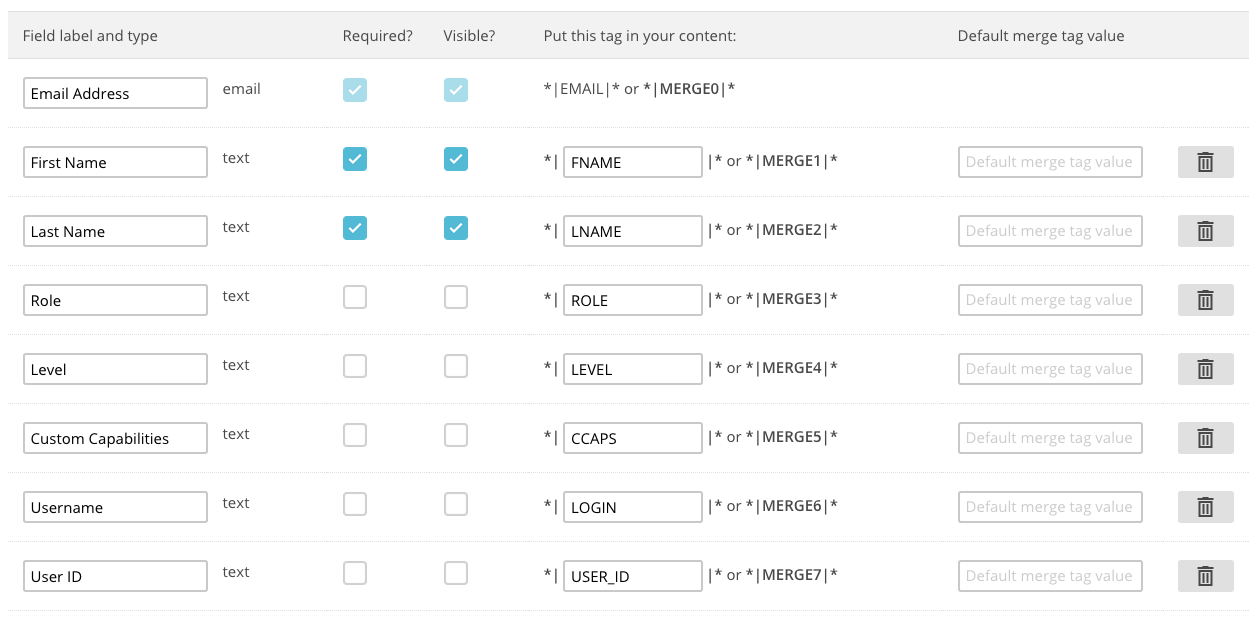12
Mar, 2015
Mar, 2015
Can I add custom mail merge fields?
Table of Contents
This requires an MU plugin with a custom filter.
For MailChimp
Please create this directory and file:
/wp-content/mu-plugins/s2-hacks.php
Read over the instructions in the code below, and adjust as necessary.
<?php
add_filter('ws_plugin__s2member_mailchimp_merge_array', function ($custom_fields, $vars)
{
$args = &$vars['args']; // stdClass object.
# print_r($args); // for a full list of all properties.
$custom_fields = array_merge($custom_fields, array(
'ROLE' => $args->role,
'LEVEL' => $args->level,
'CCAPS' => $args->ccaps,
'LOGIN' => $args->login,
'USER_ID' => $args->user_id,
// A Custom Registration/Profile Field in s2Member can be obtained like this.
// Note that `my_custom_field_id` should be replaced with the Unique ID that you configured for a field in s2Member.
// 'MY_CUSTOM_FIELD' => get_user_field('my_custom_field_id', $args->user_id),
));
return $custom_fields;
// Note that custom fields (aka: merge tags) will NOT work unless & until they are created by
// a site owner working inside their MailChimp account. They must first add the custom fields
// so they can be filled by the s2Member filter seen here.
// See: <http://kb.mailchimp.com/merge-tags/using/getting-started-with-merge-tags>
}, 10, 2);
Tip: On the Mailchimp side, you should have the following MERGE fields configured as so.
For AWeber
Please create this directory and file:
/wp-content/mu-plugins/s2-hacks.php
Read over the instructions in the code below, and adjust as necessary.
<?php
add_filter('ws_plugin__s2member_aweber_custom_fields_array', function ($custom_fields, $vars)
{
$args = &$vars['args']; // stdClass object.
# print_r($args); // for a full list of all properties.
$custom_fields = array_merge($custom_fields, array(
'role' => $args->role,
'level' => $args->level,
'ccaps' => $args->ccaps,
'login' => $args->login,
'user_id' => $args->user_id,
// A Custom Registration/Profile Field in s2Member can be obtained like this.
// Note that `my_custom_field_id` should be replaced with the Unique ID that you configured for a field in s2Member.
// 'my_custom_field' => get_user_field('my_custom_field_id', $args->user_id),
));
return $custom_fields;
// Note that custom fields (as seen above) will NOT work unless & until they are created by
// a site owner working inside their AWeber account. They must first add the custom fields
// so they can be filled by the s2Member filter seen here.
// See: <https://www.aweber.com/users/settings/custom_fields>
}, 10, 2);
For GetResponse
Please create this directory and file:
/wp-content/mu-plugins/s2-hacks.php
Read over the instructions in the code below, and adjust as necessary.
<?php
add_filter('ws_plugin__s2member_getresponse_customs_array', function ($custom_fields, $vars)
{
$args = &$vars['args']; // stdClass object.
# print_r($args); // for a full list of all properties.
$custom_fields = array_merge($custom_fields, array(
array('name' => 'role', 'content' => (string) $args->role),
array('name' => 'level', 'content' => (string) $args->level),
array('name' => 'ccaps', 'content' => (string) $args->ccaps),
array('name' => 'login', 'content' => (string) $args->login),
array('name' => 'user_id', 'content' => (string) $args->user_id),
// A Custom Registration/Profile Field in s2Member can be obtained like this.
// Note that `my_custom_field_id` should be replaced with the Unique ID that you configured for a field in s2Member.
// array('name' => 'my_custom_field', 'content' => get_user_field('my_custom_field_id', $args->user_id)),
));
foreach ($custom_fields as $_key => $_field) {
if (!isset($_field['content'][0])) unset($custom_fields[$_key]);
} // GetResponse will choke if you send them empty field content. Remove empty values here.
return array_values($custom_fields);
// Note that custom fields (as seen above) will NOT work unless & until they are created by
// a site owner working inside their GetResponse account. They must first add the custom fields
// so they can be filled by the s2Member filter seen here.
// See: <http://support.getresponse.com/faq/what-is-a-custom-field>
}, 10, 2);
